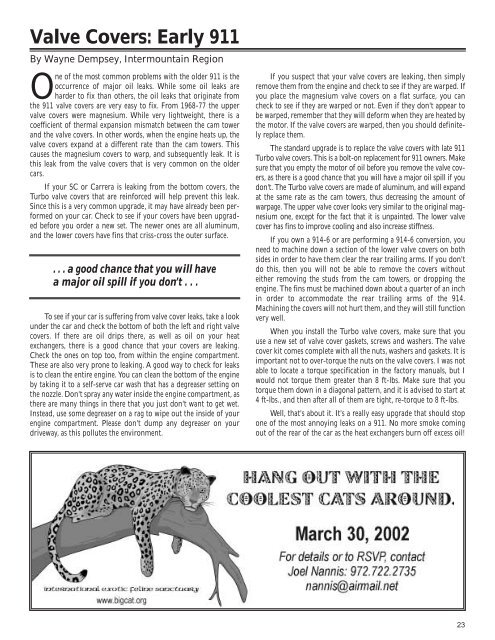Slipstream - February 2002
The monthly newsletter of the Maverick Region of the Porsche Club of America
The monthly newsletter of the Maverick Region of the Porsche Club of America
You also want an ePaper? Increase the reach of your titles
YUMPU automatically turns print PDFs into web optimized ePapers that Google loves.
Valve Covers: Early 911<br />
By Wayne Dempsey, Intermountain Region<br />
One of the most common problems with the older 911 is the<br />
occurrence of major oil leaks. While some oil leaks are<br />
harder to fix than others, the oil leaks that originate from<br />
the 911 valve covers are very easy to fix. From 1968-77 the upper<br />
valve covers were magnesium. While very lightweight, there is a<br />
coefficient of thermal expansion mismatch between the cam tower<br />
and the valve covers. In other words, when the engine heats up, the<br />
valve covers expand at a different rate than the cam towers. This<br />
causes the magnesium covers to warp, and subsequently leak. It is<br />
this leak from the valve covers that is very common on the older<br />
cars.<br />
If your SC or Carrera is leaking from the bottom covers, the<br />
Turbo valve covers that are reinforced will help prevent this leak.<br />
Since this is a very common upgrade, it may have already been performed<br />
on your car. Check to see if your covers have been upgraded<br />
before you order a new set. The newer ones are all aluminum,<br />
and the lower covers have fins that criss-cross the outer surface.<br />
. . . a good chance that you will have<br />
a major oil spill if you don’t . . .<br />
To see if your car is suffering from valve cover leaks, take a look<br />
under the car and check the bottom of both the left and right valve<br />
covers. If there are oil drips there, as well as oil on your heat<br />
exchangers, there is a good chance that your covers are leaking.<br />
Check the ones on top too, from within the engine compartment.<br />
These are also very prone to leaking. A good way to check for leaks<br />
is to clean the entire engine. You can clean the bottom of the engine<br />
by taking it to a self-serve car wash that has a degreaser setting on<br />
the nozzle. Don't spray any water inside the engine compartment, as<br />
there are many things in there that you just don't want to get wet.<br />
Instead, use some degreaser on a rag to wipe out the inside of your<br />
engine compartment. Please don't dump any degreaser on your<br />
driveway, as this pollutes the environment.<br />
If you suspect that your valve covers are leaking, then simply<br />
remove them from the engine and check to see if they are warped. If<br />
you place the magnesium valve covers on a flat surface, you can<br />
check to see if they are warped or not. Even if they don't appear to<br />
be warped, remember that they will deform when they are heated by<br />
the motor. If the valve covers are warped, then you should definitely<br />
replace them.<br />
The standard upgrade is to replace the valve covers with late 911<br />
Turbo valve covers. This is a bolt-on replacement for 911 owners. Make<br />
sure that you empty the motor of oil before you remove the valve covers,<br />
as there is a good chance that you will have a major oil spill if you<br />
don't. The Turbo valve covers are made of aluminum, and will expand<br />
at the same rate as the cam towers, thus decreasing the amount of<br />
warpage. The upper valve cover looks very similar to the original magnesium<br />
one, except for the fact that it is unpainted. The lower valve<br />
cover has fins to improve cooling and also increase stiffness.<br />
If you own a 914-6 or are performing a 914-6 conversion, you<br />
need to machine down a section of the lower valve covers on both<br />
sides in order to have them clear the rear trailing arms. If you don't<br />
do this, then you will not be able to remove the covers without<br />
either removing the studs from the cam towers, or dropping the<br />
engine. The fins must be machined down about a quarter of an inch<br />
in order to accommodate the rear trailing arms of the 914.<br />
Machining the covers will not hurt them, and they will still function<br />
very well.<br />
When you install the Turbo valve covers, make sure that you<br />
use a new set of valve cover gaskets, screws and washers. The valve<br />
cover kit comes complete with all the nuts, washers and gaskets. It is<br />
important not to over-torque the nuts on the valve covers. I was not<br />
able to locate a torque specification in the factory manuals, but I<br />
would not torque them greater than 8 ft-lbs. Make sure that you<br />
torque them down in a diagonal pattern, and it is advised to start at<br />
4 ft-lbs., and then after all of them are tight, re-torque to 8 ft-lbs.<br />
Well, that's about it. It's a really easy upgrade that should stop<br />
one of the most annoying leaks on a 911. No more smoke coming<br />
out of the rear of the car as the heat exchangers burn off excess oil!<br />
23


















